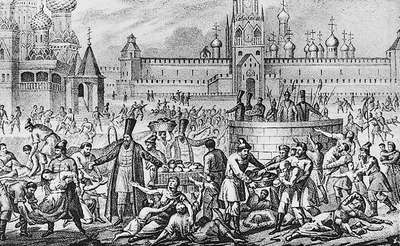Russian famine of 1601–03

The Russian famine of 1601–1603 was Russia's worst famine in terms of proportional effect on the population, killing perhaps two million people, a third of Russian people, during the Time of Troubles, when the country was unsettled politically and later invaded by the Polish-Lithuanian Commonwealth. The many deaths contributed to social disruption and helped bring about the downfall of Boris Godunov, elected as tsar during the interregnum. The famine was part of worldwide record cold winters and crop disruption, which in 2008 geologists linked to the 1600 volcanic eruption of Huaynaputina in Peru.[1]
Causes
A 2008 study by Kenneth L. Verosub and Jake Lippman documents worldwide famine after the eruption of a volcano in Peru in 1600.[2] Huaynaputina ejected 16 million to 32 million metric tons of particulates into the atmosphere, notably sulfur dioxide, forming sulfuric acid and creating a volcanic winter; this reduced the amount of sunlight reaching the Earth's surface (see Albedo), which scientists believe contributed to bitterly cold winters, loss of crops and animals, and massive famine around the world. As a result, people killed many animals with their bare hands to preserve their furs for warmth.[3][4][5]
The famine was documented across the world: "Records from Switzerland, Latvia and Estonia record exceptionally cold winters in 1600–1602; in France, the 1601 wine harvest was late, and wine production collapsed in Germany and Colonial Peru. In China, peach trees bloomed late, and Lake Suwa in Japan had one of its earliest freezing dates in 500 years."[3]
Number of dead
During this two-and-a-half-year period, 127,000 bodies were buried in mass graves in Moscow alone. Widespread starvation killed perhaps two million in Russia, a third of the population. The suffering and social disruption were part of the political unrest called the Time of Troubles, which led to the downfall of Tsar Boris Godunov.[3] Having previously acted as regent for Tsar Feodor, Godunov was elected to succeed him during an interregnum.
See also
References
- ↑ Perkins, S. (2009). "Disaster goes global: The eruption in 1600 of a seemingly quiet volcano in peru changed global climate and triggered famine as far away as Russia". Science News. 174 (5): 16. doi:10.1002/scin.2008.5591740519.
- ↑ Verosub, K. L.; Lippman, J. (2008). "Global Impacts of the 1600 Eruption of Peru's Huaynaputina Volcano". Eos, Transactions American Geophysical Union. 89 (15): 141. doi:10.1029/2008EO150001.
- 1 2 3 "1600 Eruption Caused Global Disruption", Geology Times, 25 Apr 2008, accessed 13 Nov 2010.
- ↑ Andrea Thompson, "Volcano in 1600 caused global disruption", MSNBC.com, 5 May 2008, accessed 13 Nov 2010.
- ↑ "The 1600 eruption of Huaynaputina in Peru caused global disruption", Science Centric.